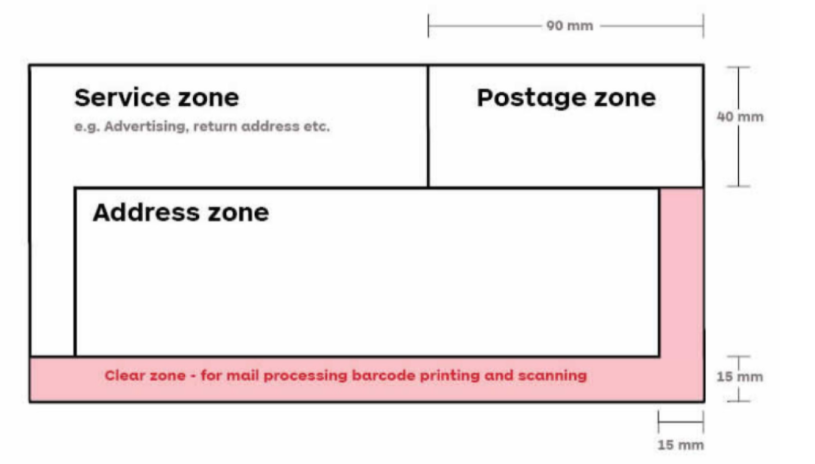
Australia Address Format: How to Correctly Address Mail Going to Australia
Companies often tend to overlook the significance of the address format in their direct mail communications. As a result, companies often end up having low-performing direct mail campaigns that can not get them the desired result.

As we all know, most direct mail communications and marketing campaigns are time-bound. Using an improper address format for your bulk mail can significantly delay your postal mail delivery. In some cases, even the campaign’s deliverability rate may be affected badly.
Hence, it is crucial to understand why a valid address format is vital for your direct mail campaigns. Additionally, businesses need to learn more about writing appropriately formatted addresses for their direct mail operations and efficiently optimize them.
This article is a one-stop destination for accomplishing all of these things in a single go. So let’s get started straight away.
Key Takeaways:
- Australia Post relies on a machine to sort direct mail. To make sure your mail gets to the right place on time, you have to use a specific, correct address format that their system can read.
- The Australian address has a particular three-line structure you’ll want to follow. The first line is for the receiver’s name, the second is for street details, and the third line is for the place name, state abbreviation, and postcode. All of these should be in all caps with no punctuation.
- If you’re sending mail internationally, for example, from Canada to Australia, you need to add a fourth line. This line should contain only the country name, written in all capital letters.
- For the best chance of successful delivery, stick to a simple black-on-white color scheme. It’s also a good idea to avoid underlining the address, as this can confuse the automated sorting machines.
- Trying to keep track of all these rules for a large bulk mailing can be a real headache. A tool like PostGrid’s Address Verification solution can simplify the process and make sure every single address is deliverable and correct.
Why Is Australia Mailing Address Format So Important?
Australia Post always encourages its customers to address their mailers correctly as per a predefined standard. You may have wondered why the Australian address format is so important when you already have the accurate address.
Businesses may think that as long as they have the accurate address of the recipient printed on the mailer, everything is alright. However, that is not the case. Many of you may not yet know that Australia Post does not sort mailers manually anymore.
They use an advanced letter-sorting technology that electronically reads the addresses. If you use an incorrect address format, the system may not read it. Therefore, you must address your mail correctly if you want to ensure its accurate and timely delivery.
Impact of Address Formats on Different Industries
- Healthcare and Fintech: These industries have a high need for maintaining privacy and security. So it is essential to have the mail address in the appropriate format to ensure correct delivery. Delivery to the wrong address can result in a data breach, compromising sensitive information.
- Ecommerce: Incorrect addresses mean failed deliveries, which leads to lost products and high reshipping costs. This cost can directly impact the company’s profits and customer experience.
- Logistics and Supply Chain: Standardized addresses are imperative for efficient route planning and mail sorting. Incorrect addresses can require manual intervention, which increases operational costs and leads to unnecessary delays.
Understanding The Australia Address Format
The address side of your mailer is divided into four distinct zones, and they are as follows:
- Service Zone
- Postage Zone
- Address Zone
- Clear Zone

Service Zone
The service zone is where you can add parts of your advertisement. However, the service zone on the address side is not the primary option for printing your ads because you have the entire backside for it. It is at least 40mm from the top edge of the mailer and 90mm away from the right edge.
Additionally, this zone can also contain the return address. You may think that a return address is unnecessary for your mailer. Still, it can be beneficial in determining the return rate of business mailers. You can also opt for innovative ways to print the return address to minimize the space it occupies.
Postage Zone
The postage zone is where you stick the necessary postage for your mailer. It can include stamps, postmarks, and postage meter imprints. Usually, you can find this zone in the envelope’s upper right corner. It must extend at least 40mm from the top edge of the mailer and 90mm from the right edge.
Address Zone
A mailer’s address zone is probably the most significant part of the mailer. It is where you can write or print the recipient’s delivery address. Usually, the Australia mailing address format has the address printed roughly in the centre of the envelope.
When mailing from Canada to Australia, you must ensure that the address doesn’t go all the way to the bottom or right edges, as there is a 15mm clear zone. This Australia address format enables Australia Post’s system to read the address and sort it quickly.
Clear Zone
The clear zone is a 15mm wide space along the bottom and right edge of the postal mail envelope. The purpose of the clear zone in postal mail is to ensure that the sender does not write the address towards the very edge of the envelope.
There are some practical uses for this. For example, if you write the address too close to the edge there is a chance that you may end up not having enough space. You may then have to use a hyphen in the address or compromise the readability of the address. The clear zone prevents this and ensures good readability for your delivery addresses.
Australia Post reserves the clear zone for printing the barcode and sorting their mailers.
How To Write Australia Home Address?
Now that we know where you have to write an Australian address, let’s see how you should write it when mailing from Canada. Before you write the address for postal mail, you need to understand the Australian mailing address format.
Usually, the Australian address has three lines.
Line 1:
The top or first line of the Australian address format should include the recipient’s name. You may have noticed that providing the recipient’s name on the first line of the postal mail is a standard practice almost everywhere.
However, some people still make the mistake of writing the rest of the addresses on the same line. So, make sure that you don’t make the same mistake under any circumstances because even such a trivial mistake can cause delays in your direct mail delivery.
Line 2:
The second line of the Australia home address should contain details such as:
- Name of the street
- Street number
- PO Box number
- Locked bag number (only if applicable)
Line 3:
The third and last Australia address line should contain the details of the recipient’s locations, such as:
- Place name
- Post Office of delivery
- Abbreviation of the state or territory
- Postcode
You should also note that the last line should use capital letters for every word. Furthermore, you can not use any underlining or punctuation in the very last line of the Australia address. It is also worth noting that the postcode is only added to the address at the end.
Note: If you are sending international mail, you should write or print the country name in capital letters.
Common Mistakes with International Address Formats
- Forgetting to write the country name in capital letters. This is a mandate for international direct mail.
- Applying Canadian address formats can confuse foreign postal systems.
- Assuming abbreviations are universal. State or province abbreviations valid in one country may not be internationally recognized.
- Ignoring international punctuation rules can lead to an error in being read by automated sorting machines.
Quick Tips For Addressing Australia Post Envelopes
Australian mailing address format may sometimes be confusing, especially for businesses that send direct mail in bulk. However, some tips can help you ensure that you have the correct address for your mailer. Use the following directions to ensure the maximum deliverability of your direct mail.
#1 Ensure The Accuracy Of Your Postcode
Postcodes are arguably the most crucial part of an Australian address. Unfortunately, it is also the most error-prone part of the address.
You need to ensure that the postcode on your mailers is accurate. To find the postcode for individual postal addresses, you can use Australia Post’s Find a Postcode tool.
On the other hand, if you are sending mailers in bulk, you need a more advanced address verification system like PostGrid.
#2 Ensure Quality Printing
Quality printing of mailers involves using high-quality ink and paper for your postal mailers. The preferred colour combination for postal mail is black on white. Additionally, it would be best not to use ink colours such as red, yellow, and orange as it can affect readability.
#3 Avoid Indented Or Staggered Address Lines
Indenting or staggering address lines can also affect the deliverability of your direct mail. An easy solution to this would be to standardize the addresses on your mailers via an advanced tool like PostGrid.
#4 Avoid Unlining
When it comes to the Australian mailing address format, you should never use underlining in the address. Using underlines in the postal address may cause readability issues for Australia Post’s mail sorting system.
#5 Always Include A Return Address
Australia Post suggests that you always include a return address on the mailer. That way, you always understand which of your recipients have an undeliverable address and avoid unnecessary expenses.
#6 Use Pre-Printed Envelopes
Pre-printed envelopes are a great way to avoid unwanted errors in your direct mail process. You can even use address verification systems like PostGrid to verify an address and print the postcode beforehand.
#7 Including Traditional Place Names
You can opt to include the traditional place names in the addresses of your direct mail campaign to acknowledge the traditional custodians of the land. Using traditional place names is an opportunity to show that you value the history and heritage of the country.
To learn more about traditional names, visit AIATSIS or directly go to your area’s Aboriginal and Torres Strait Islander Land Councils or Cultural Centres. It is also worth noting that you can include the traditional name in both the ‘to’ and ‘from’ addresses of the mailer.
 Also Read: Canada Post Hold Mail
Also Read: Canada Post Hold MailSend Automated Postal Mail From Canada To Australia Via PostGrid
Above we saw how you can correctly write the Australia address format for ensuring the efficient delivery of your mailers. But it is important to remember that Canada Post needs to hand over your mailer to Australia Post first.
Canada Post has its own standards for sending international mailers. Your mailer must include the following details for Canada Post to successfully deliver it.
- First Line: Name of the addressee
- Second Line: Delivery address (as per Australia Address Format)
- Third Line: Municipality name, state or province, and postal code
- Fourth Line: Country name (In this case, Australia)
It can be confusing to keep track of all these details manually, especially for bulk mail. PostGrid offers an easy solution to this problem. PostGrid lets you automate the entire direct mail process, and the system will standardize the address for you.
Furthermore, PostGrid’s direct mail system has relevant compliances from both Canada Post and Australia Post. Hence, you can be sure that the system delivers your mailer accurately and efficiently to their destinations.
Send Automated Postal Mail From Canada To Australia Via PostGrid
Above, we saw how you could correctly write the Australia address format to ensure your mailers’ efficient delivery. But, it is essential to remember that Canada Post needs to hand over your mailer to Australia Post first.
Canada Post has its standards for sending international mailers. Your mailer must include the following details for Canada Post to deliver it successfully.
- First Line: Name of the addressee
- Second Line: Delivery address (as per Australia Address Format)
- Third Line: Municipality name, state or province, and postal code
- Fourth Line: Country name (In this case, Australia)
It can be challenging to keep track of all these details manually, especially for bulk mail. PostGrid offers an easy solution to this problem. PostGrid lets you automate the entire direct mail process, and the system will standardize the address for you.
Furthermore, PostGrid’s direct mail system has relevant compliance from Canada Post and Australia Post. Hence, you can ensure that the system delivers your mailers accurately and efficiently to their destinations.
Conclusion
Businesses that regularly use direct mail should never underestimate the importance of Australia mailing address format. Proper use of the Australia address format ensures your mailers’ timely and accurate delivery.
Companies must invest in an advanced address verification tool like PostGrid to optimize their business communication. An AMAS-certified address verification software like PostGrid can access the official address database of Australia Post and validate the addresses.
Furthermore, PostGrid’s system even standardizes the addresses as part of its verification process. The fully automated direct mail system can personalize and print standardized addresses for all your mailers. As a result, you can automate your entire direct mail process with the click of a button.
So, if you want the best result for your business’s direct mail operations, then you must make use of robust automation software like PostGrid. The sooner you do, the better it is for your business and its direct mail campaigns.









